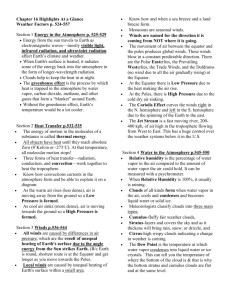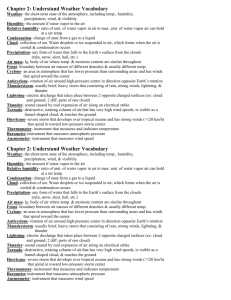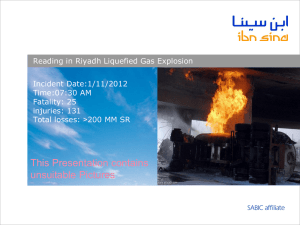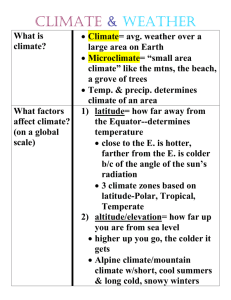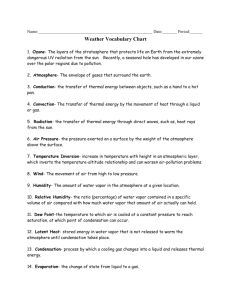Name: Hour: Atmosphere Chapter 2 Study Guide Vocab to Know: Air
advertisement
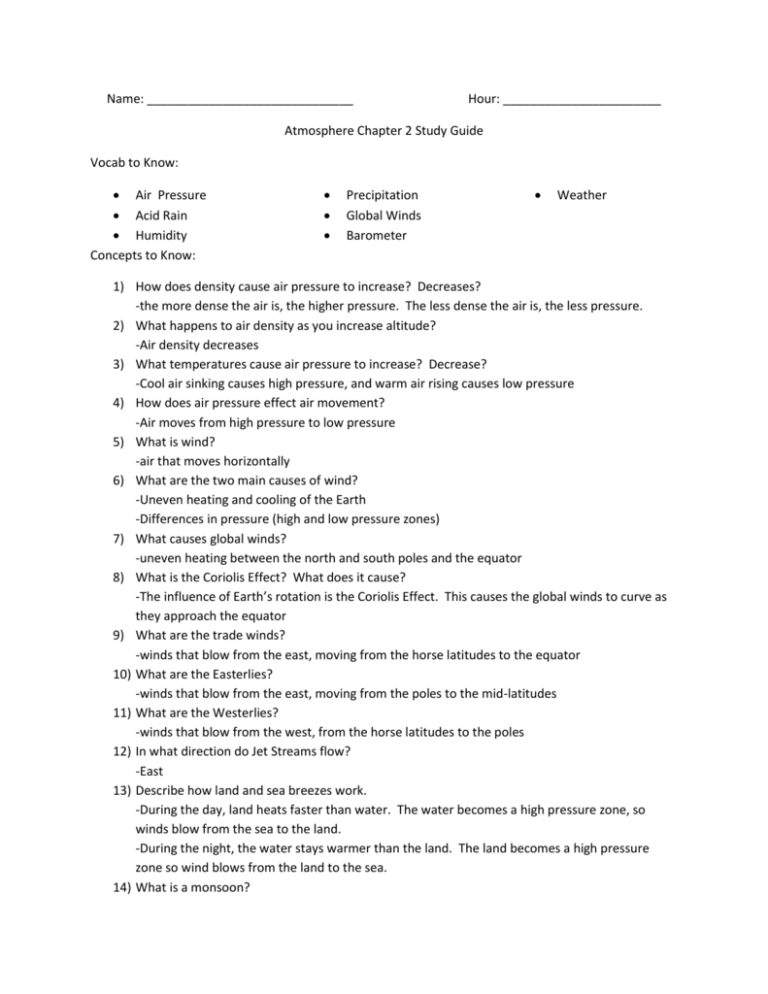
Name: ______________________________ Hour: _______________________ Atmosphere Chapter 2 Study Guide Vocab to Know: Air Pressure Acid Rain Humidity Concepts to Know: Precipitation Global Winds Barometer Weather 1) How does density cause air pressure to increase? Decreases? -the more dense the air is, the higher pressure. The less dense the air is, the less pressure. 2) What happens to air density as you increase altitude? -Air density decreases 3) What temperatures cause air pressure to increase? Decrease? -Cool air sinking causes high pressure, and warm air rising causes low pressure 4) How does air pressure effect air movement? -Air moves from high pressure to low pressure 5) What is wind? -air that moves horizontally 6) What are the two main causes of wind? -Uneven heating and cooling of the Earth -Differences in pressure (high and low pressure zones) 7) What causes global winds? -uneven heating between the north and south poles and the equator 8) What is the Coriolis Effect? What does it cause? -The influence of Earth’s rotation is the Coriolis Effect. This causes the global winds to curve as they approach the equator 9) What are the trade winds? -winds that blow from the east, moving from the horse latitudes to the equator 10) What are the Easterlies? -winds that blow from the east, moving from the poles to the mid-latitudes 11) What are the Westerlies? -winds that blow from the west, from the horse latitudes to the poles 12) In what direction do Jet Streams flow? -East 13) Describe how land and sea breezes work. -During the day, land heats faster than water. The water becomes a high pressure zone, so winds blow from the sea to the land. -During the night, the water stays warmer than the land. The land becomes a high pressure zone so wind blows from the land to the sea. 14) What is a monsoon? 15) 16) 17) 18) 19) 20) 21) 22) 23) 24) 25) 26) -winds that change with the seasons What is evaporation? -the change of liquid water to gas What is condensation? -the change of water vapor to liquid water What is relative humidity? -compares the amount of water vapor in the air with the maximum amount of water vapor that can be present at the temperature Describe how a cloud forms. -water evaporates from the Earth’s surface and rises through the air as water vapor. As the water vapor rises, it cools the higher in altitude it goes. When the water vapor cools enough, it condenses to form a cloud. What are the main characteristics of a cirrus cloud? -form in cold air at high altitudes -made of ice crystals -have a feathery appearance -show in fair weather, but a sign rain might be coming What are the main characteristics of a stratus cloud? -form in layers -smooth because of strong air movement -dark clouds that produce steady, light precipitation What are the main characteristics of a cumulus cloud? -puffy white clouds with darker bases -appear in fair weather -grows taller as time passes -tallest are cumulonimbus clouds that produce large thunderstorms What does “alto” mean? -middle altitude What does “nimbo” mean? -precipitation What is sleet? -rain that freezes into ice pellets as it falls through cold air What is freezing rain? -rain that freezes when it hits the ground or other surfaces What is hail? -forms when ice pellets move up and down in the clouds, growing larger as they gain layers of ice




